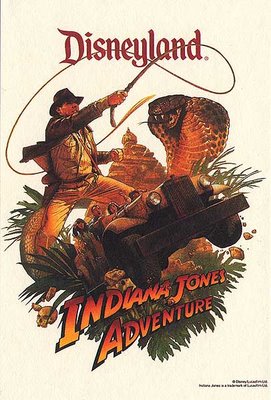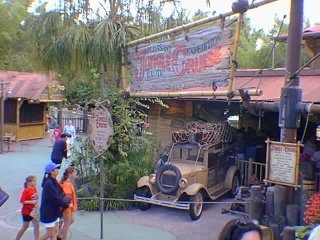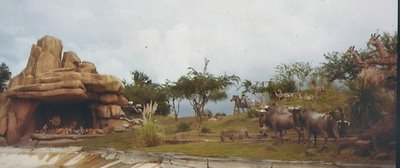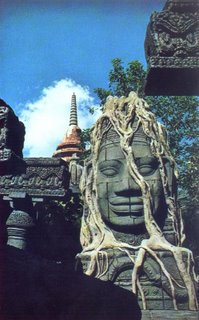 Let us take a moment here, between articles, to admire the succinct but brilliantly constructed lost art form which was the Walt Disney World "pictorial souvenir" produced between 1971 and 1992 or so. These large, in later years often hardcover, books were simply thick with the kind of taut, evocative and smart ad copy Disney only wishes she could write today. Take this passage from a 1977 book:
Let us take a moment here, between articles, to admire the succinct but brilliantly constructed lost art form which was the Walt Disney World "pictorial souvenir" produced between 1971 and 1992 or so. These large, in later years often hardcover, books were simply thick with the kind of taut, evocative and smart ad copy Disney only wishes she could write today. Take this passage from a 1977 book:"A world of discoveries awaits visitors at the Walt Disney World Shopping Village. In a setting of weathered bricks and woods, and shops with cedar-shingled roofs, old-world craftsmen carry out their vintage arts before admiring eyes..."
And all this for the fairly sedate Disney Marketplace! Furthermore, the imagery was striking and often wonderful, capturing beautiful settings in flattering light at all times of the day with real people in real clothes enjoying themselves in real time. In honor of this lost art, we proudly present to you a collection of staggering vintage promotional imagery with accompanying text. Always click on the image for a larger view if possible; many are scanned at very high resolution.

"Crossing the bridge and climbing the Swiss Family Treehouse, adventurers gain a spectacular panorama of the sprawling jungle region. Below, bargain hunters browse through informal tropical shops."
"A journey to exotic tropical regions of the world unfolds in Adventureland, where the last outpost of civilization borders on a "wonderland of nature's own design."
"A veritable United Nations of plants was assembled to represent the tropic regions of the world. From the South Pacific to the West Indies, from darkest Africa to densest Amazon, flowering trees radiate the spectrum in brilliant, ever changing patterns of blossoms. Vigorously twining vines and vast strands of bamboo, palms, ferns and grasses add contrasting textures and cooling shades of green."


"Man is on the move in Tomorrowland - across America, around our world, and beyond the earth into Outer Space... For youngsters of all ages, Tomorrowland is a stepping stone to the future... an opportunity today to preview many adventures which only yesterday seemed generations away." [Editor's emphasis]
"In addition to being astronomically enlightening, [Mission to Mars] is rich in light-hearted embellishments. Among them is a cosmic phenomenon that hurls passengers into a 'hyper-space warp' and through an 'anti-universe' mirroring their own."

"Enclosed within the hotel's imposing steel and concrete A-frame is an enourmous open area called the Grand Canyon Concourse. It soars nine stories and stretches one and a half times the length of a football field, with rows of guest rooms opening into it on both sides. Sleek, silent monorail trains continually arrive and depart in this unique 'lobby', transporting guests to and from The Magic Kingdom and other resort destinations. Beneath the monorail station is a small community of shops and restraunts, set in a shimmering decor inspired by scenes of the Grand Canyon."

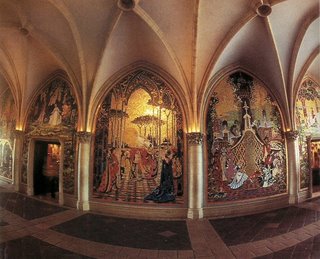
Just look at those clean cut, white, lying 'tourists' clad entirley in Disney garb clutching their mouse ears and faking a turn on Big Thunder Mountain Railroad! The illusion of them actually expirencing the attraction in a nonstaged format is so artifical that the slightly canted camera angle to help the trick is noticable, and Ms. Blonde on the right is even looking square into the camera! The difference between this offensivley bland American grouping and a cool guy with an afro riding his Grand Prix Raceway car past a blurry Contemporary is about as stark as you can get. And is that a fish eye lens you're using on the Castle Mosiacs there, Mickey? Why? So you can get all of them in one shot? Where's the art?
As for the prose, I only need to cite two passages from two different years to illustrate what happened:
"Among the most popular attractions in The Magic Kingdom, Country Bear Jamboree is a complete theatrical production, relying on precise timing of humorous patter and songs. And most of all, it relies on the ability of the Disney Imagineers to create incredibly life-like personalities for an Audio-Animatronics cast that includes 17 full sized bears, a raccoon, and the talktative hunting-trophy heads of a buffalo, stag and moose." Walt Disney World: The First Decade, 1981
"At Grizzly Hall, Audio-Animatronics bears, a racoon [sic], and talking buffalo, stag, and moose heads present The Country Bear Jamboree. One of the most popular stage shows in The Magic Kingdom, it relies on precision timing and stars like Teddi Barra, Big Al, and Liver Lips." Walt Disney World Resort, 1994These wonderful old volumes are invaluable resources now, and some, like Walt Disney World: The First Decade, and Walt Disney's Epcot Center, are literally cornerstone works on any Disney shelf. By the mid-90's the books were fully "Eisnerized", with full color characters composited onto awkwardly taken images of actors pretending to be guests, and much of the charm was gone. Please, Disney, bring back these big old hardcover books with unique text and custom photographs - there are plenty of us willing to shell out top dollar for this kind of thing again and you know it.










